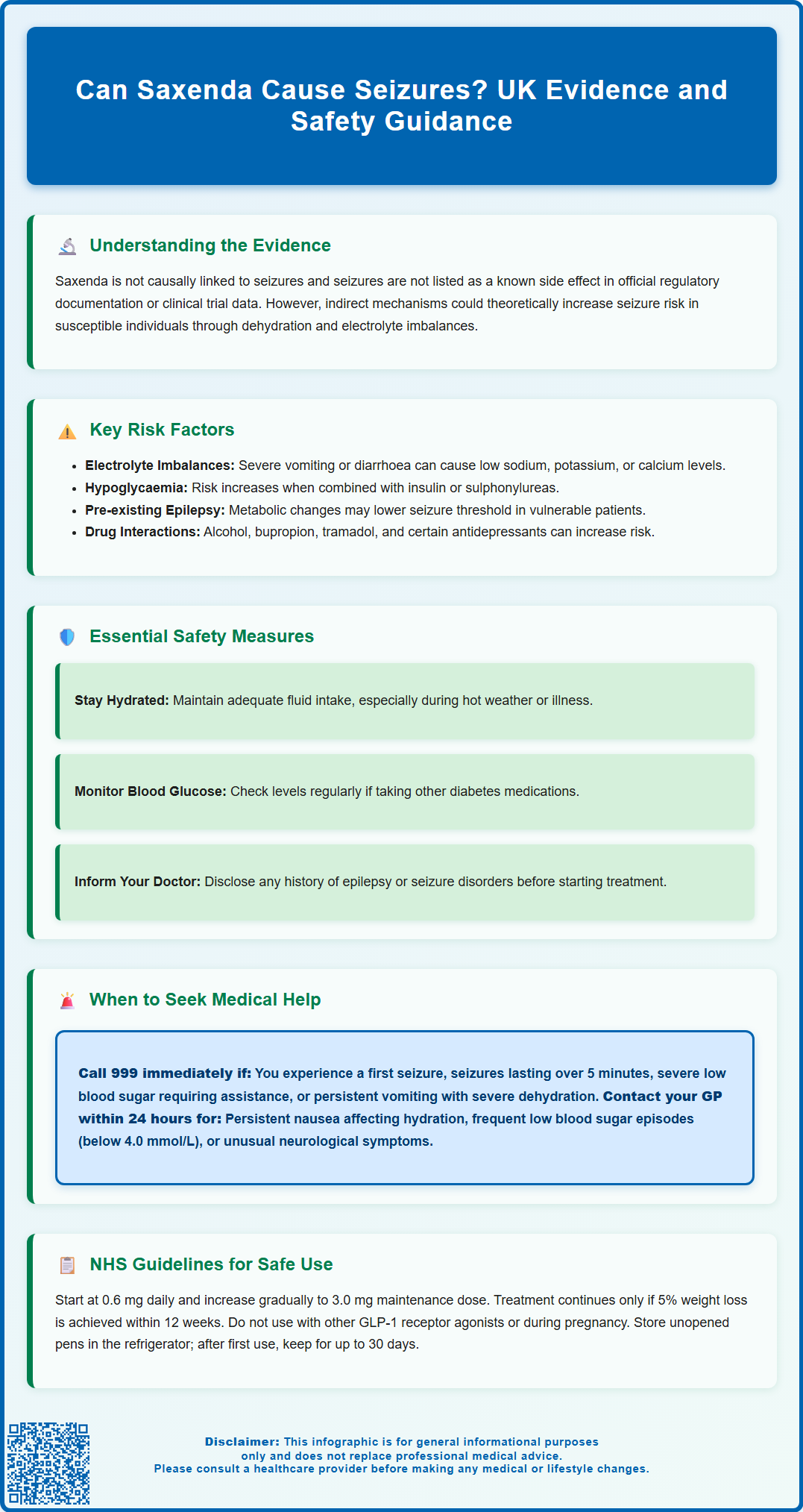Wegovy®
A weekly GLP-1 treatment proven to reduce hunger and support meaningful, long-term fat loss.
- ~16.9% average body weight loss
- Boosts metabolic & cardiovascular health
- Proven, long-established safety profile
- Weekly injection, easy to use

Can Saxenda cause seizures? This is a common concern among patients considering liraglutide 3.0 mg for weight management. Saxenda is a glucagon-like peptide-1 (GLP-1) receptor agonist licensed in the UK for obesity treatment in adults with specific clinical criteria. Current evidence shows no established causal link between Saxenda and seizures. The medication is not listed as causing seizures in the Summary of Product Characteristics approved by the MHRA or EMA. However, indirect factors such as dehydration, electrolyte imbalances, or hypoglycaemia may theoretically affect seizure risk in susceptible individuals. Understanding these mechanisms helps patients and clinicians make informed decisions about safe Saxenda use.
Summary: Saxenda does not directly cause seizures and seizures are not listed as a recognised adverse effect in UK regulatory guidance.
Saxenda (liraglutide 3.0 mg) is a glucagon-like peptide-1 (GLP-1) receptor agonist licensed in the UK for weight management in adults with obesity or overweight with weight-related comorbidities. Whilst Saxenda has demonstrated efficacy in clinical trials, patients and healthcare professionals often enquire about potential neurological adverse effects, including seizures.
There is no established causal link between Saxenda and seizures in the current evidence base. Seizures are not listed as a known adverse reaction in the Summary of Product Characteristics (SmPC) approved by the Medicines and Healthcare products Regulatory Agency (MHRA) or the European Medicines Agency (EMA). Post-marketing surveillance data and large-scale clinical trials have not identified seizures as a recognised side effect of liraglutide at therapeutic doses.
However, it is important to understand that indirect mechanisms could theoretically contribute to seizure risk in susceptible individuals. Saxenda can cause gastrointestinal side effects such as nausea, vomiting, and diarrhoea, which may lead to dehydration and electrolyte imbalances. Severe electrolyte disturbances—particularly hyponatraemia (low sodium)—can lower the seizure threshold in vulnerable patients. Additionally, Saxenda may increase the risk of hypoglycaemia specifically when used alongside insulin or sulphonylureas, and severe hypoglycaemia is a recognised precipitant of seizures. Dose reductions of these medications may be necessary when starting Saxenda.
Patients with a pre-existing seizure disorder or epilepsy should discuss their medical history with their prescribing clinician before starting Saxenda. Whilst the medication itself does not directly cause seizures, maintaining adequate hydration and ensuring appropriate blood glucose control are essential safety measures for all patients using this weight loss treatment. Electrolyte monitoring may be indicated for patients experiencing significant vomiting or diarrhoea, or those with other risk factors.
Understanding individual risk factors is crucial when considering any weight loss medication, including Saxenda. Certain patient characteristics and clinical scenarios may increase vulnerability to seizures, even if the medication itself is not directly epileptogenic.
Key risk factors include:
Pre-existing epilepsy or seizure disorders – Patients with a history of seizures require careful monitoring, as metabolic disturbances or medication interactions could lower seizure threshold
Electrolyte imbalances – Severe vomiting or diarrhoea (common with GLP-1 agonists) can lead to hyponatraemia, hypokalaemia, or hypocalcaemia, all of which may precipitate seizures
Hypoglycaemia – Particularly relevant in patients taking Saxenda alongside insulin or sulphonylureas; clinically significant hypoglycaemia (<3.0 mmol/L) or severe hypoglycaemia (requiring assistance from another person) can trigger seizures
Alcohol excess – Both acute intoxication and withdrawal can lower seizure threshold, and alcohol may exacerbate gastrointestinal side effects of Saxenda
Concurrent medications – Certain drugs lower seizure threshold, including bupropion, tramadol, and some antidepressants and antipsychotics (as noted in their respective BNF monographs)
Metabolic disturbances – Significant changes in metabolism during weight loss may affect medication requirements and physiological balance in some individuals
Healthcare professionals should conduct a thorough medical history before prescribing Saxenda, specifically enquiring about previous seizures, neurological conditions, and current medications. NICE guidance on obesity management emphasises the importance of individualised risk assessment and regular monitoring when prescribing pharmacological interventions for weight loss. Patients should be counselled about maintaining adequate fluid intake and recognising early warning signs of dehydration or hypoglycaemia.

Patients using Saxenda should be educated about warning signs that require prompt medical attention. Whilst seizures are not a recognised direct adverse effect of liraglutide, certain symptoms may indicate complications that could increase seizure risk or represent other serious adverse events.
Seek immediate medical help (call 999 or attend A&E) if:
You experience a first seizure or a seizure lasting more than 5 minutes
You have repeated seizures without fully recovering between them
The seizure causes injury or breathing difficulties
Severe hypoglycaemia occurs – Requiring assistance from another person, loss of consciousness, inability to swallow, or seizure-like activity (particularly if taking insulin or sulphonylureas)
Signs of severe dehydration develop – Persistent vomiting, inability to keep fluids down for more than 24 hours, reduced urine output, severe dizziness, or rapid heartbeat
Symptoms of hyponatraemia appear – Severe headache, confusion, drowsiness, muscle weakness, or seizures (especially if experiencing prolonged vomiting or diarrhoea)
Contact your GP or prescribing clinician within 24 hours if you notice:
Persistent nausea or vomiting affecting your ability to maintain hydration
Frequent episodes of hypoglycaemia (blood glucose <4.0 mmol/L)
Unusual neurological symptoms such as persistent headaches, visual disturbances, or altered sensation
Worsening of pre-existing seizure control in patients with epilepsy
Patients should be advised to monitor their blood glucose regularly if taking other diabetes medications, maintain adequate fluid intake (particularly during hot weather or illness), and keep a symptom diary to identify patterns. The NHS advises that anyone experiencing a first seizure should be assessed urgently, as this requires investigation regardless of medication use. Healthcare professionals should provide clear safety-netting advice and ensure patients understand when to seek help, reinforcing that early intervention can prevent serious complications.
NICE technology appraisal guidance (TA664) recommends liraglutide 3.0 mg (Saxenda) as an option for weight management within specialist tier 3 weight management services for adults with:
A body mass index (BMI) of 35 kg/m² or more (or 32.5 kg/m² or more for people from Black, Asian and minority ethnic groups) with non-diabetic hyperglycaemia and a high risk of cardiovascular disease, or
A BMI of 35 kg/m² or more (or 32.5 kg/m² or more for people from Black, Asian and minority ethnic groups) with at least one weight-related comorbidity
Treatment should only be continued beyond 12 weeks at the 3.0 mg daily dose if the person has lost at least 5% of their initial body weight. Treatment is typically provided for a maximum of 2 years.
Key safety precautions for Saxenda use include:
Gradual dose escalation – Starting at 0.6 mg daily and increasing weekly to the maintenance dose of 3.0 mg reduces gastrointestinal side effects and associated risks of dehydration
Hydration monitoring – Patients should be counselled to maintain adequate fluid intake, particularly during the initial weeks when nausea and vomiting are most common
Blood glucose monitoring – Essential for patients with type 2 diabetes; dose reduction of concomitant insulin or sulphonylureas may be necessary to prevent hypoglycaemia
Regular review – The prescribing clinician should assess weight loss, tolerability, and adverse effects at 4–12 week intervals
Storage requirements – Refrigerate before first use; after first use, can be stored at room temperature or refrigerated for up to 30 days as specified in the SmPC
Co-administration precautions – Saxenda should not be used with other GLP-1 receptor agonists or weight-loss medicines
The SmPC includes warnings and precautions regarding thyroid C-cell tumours in rodents, including a family history of medullary thyroid carcinoma (MTC) or multiple endocrine neoplasia syndrome type 2 (MEN2). Saxenda should not be used in pregnancy or breastfeeding.
Patients with epilepsy or previous seizures should inform their healthcare provider before starting treatment. Whilst there is no direct contraindication, additional monitoring may be appropriate, particularly regarding hydration status and blood glucose control.
If you experience any side effects, talk to your doctor, pharmacist or nurse. This includes any possible side effects not listed in the package leaflet. You can also report side effects directly via the MHRA Yellow Card scheme at yellowcard.mhra.gov.uk.
Saxenda does not directly cause seizures, but patients with epilepsy should inform their prescribing clinician before starting treatment. Additional monitoring of hydration status and blood glucose control may be appropriate to prevent indirect factors that could affect seizure threshold.
Call 999 or attend A&E immediately if you experience a first seizure, a seizure lasting more than 5 minutes, or repeated seizures without full recovery. Any first seizure requires urgent medical assessment regardless of medication use.
Severe gastrointestinal side effects such as persistent vomiting or diarrhoea may lead to dehydration and electrolyte imbalances, which can lower seizure threshold in susceptible individuals. Maintaining adequate hydration and seeking medical advice for persistent symptoms is essential.
The health-related content published on this site is based on credible scientific sources and is periodically reviewed to ensure accuracy and relevance. Although we aim to reflect the most current medical knowledge, the material is meant for general education and awareness only.
The information on this site is not a substitute for professional medical advice. For any health concerns, please speak with a qualified medical professional. By using this information, you acknowledge responsibility for any decisions made and understand we are not liable for any consequences that may result.
Lorem ipsum dolor sit amet, consectetur adipiscing elit, sed do eiusmod tempor incididunt ut labore et dolore magna aliqua. Ut enim ad minim veniam, quis nostrud exercitation ullamco laboris nisi ut aliquip ex ea commodo consequat. Duis aute irure dolor in reprehenderit in voluptate velit esse cillum dolore eu fugiat nulla pariatur.
Block quote
Ordered list
Unordered list
Bold text
Emphasis
Superscript
Subscript